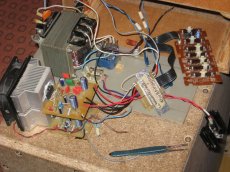Samufer Militant

Samufer militant, TDA7294
In fact, I had a surgeon assembled two more years before the sabvuffer appeared, and at that time I was puzzled by the creation of a qualitative vigilator, and that he could survive both the needs of the time and the needs in the future. As it turns out, I've predicted quite well enough) At that time (two years before the sabvuffer appeared), I had two columns C30, and they needed a qualitative assiliator. For a long time, you've decided to force the IMS, but it turns out most of these IMSs are very unsatisfactory. After a long search and analysis of materials, a very popular TDA7294 microschema was found on the Internet.
The schema of the ensemble is the practical repetition of the circuit proposed by the manufacturer. And it's not an accident - who knows how to turn it on. And I'm sure there won't be any surprises because of unstable inclusion or mode of operation.
The R1C1 input circuit is the lower frequencies filter (FNL) that cuts all over 90 kHz. Without it, the twenty-first century is primarily a century of high frequency interference. The filter cuts are quite high. But it's special-- I don't know where this surgeon will be connected. If there is a loudspeaker in the inlet, its resistance will be added to R1 and the cut frequency will decrease (the optimum value of the resistance of the volume regulator ~10 kOm, better, but the regulation will break).
The R2C2 chain then performs the opposite function - does not pass the frequency entrance below 7 Hz. If it's too low for you, the C2 capacity can be reduced. If you're so excited about the reduction of the capacity, you can stay very low. For the full C2 sound range, at least 0, 33 μg. And remember, the condensers have a very large discharge of the receptacles, so if it says 0,47 mcph, it could be that there's 0, 3! And again. On the lower limit of the range, the output power is reduced by 2 times, so it is better to choose less:
C2[mkF] = 1,000 / (6, 28 * Fmin[Hz] * R2[km]
Resistor R2 is causing the inlet resistance of the forcer. It's a little bigger than the date, but it's better - too low entry resistance can "do not like" the signal's source. Consider that if a loudspeaker is switched on before the operator, its resistance shall be 4 times less than R2, otherwise the volume control law (length of the steering angle) will change. The optimum R2 is within the range of 33...68 kOm (more resistance will reduce immunity).









